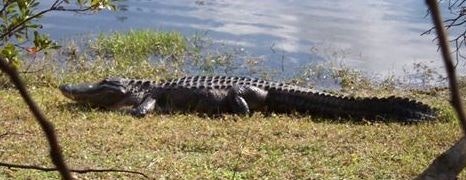Alligators- One of Florida’s most misunderstood animals

February 22, 2023 By Katie Roundtree
Did you know that your chance of being attacked by an alligator is about 1 in 24 million, while your chance of winning the Florida Lottery is about 1 in 23 million- one million times better?* Alligators are an integral part of Florida’s ecosystem and play a significant part in the ecology of our wetlands. Alligators have an important role in the food chain and help keep other animal populations in balance. They are some of Florida’s most misunderstood animals and learning a little more about them may help humans and alligators continue to coexist. Here are some important facts and tips to consider while living with alligators:
- Be aware in or near water- Never let pets or children near water unsupervised. Avoid swimming in water that is known to be inhabited by alligators. Never go into the water at night when alligators are most active. 90% of attacks occur on persons wading or swimming at the water’s edge where alligators can lunge at prey approaching the water.
- Be cautious during warmer months- Alligator mating season is between May and September. During this time male alligators are more aggressive and female alligators are protective of nests. 75% of alligator attacks occur during May – September.
- Never approach an alligator or alligator nest- Alligators that are accustomed to being fed become used to humans and lose their natural wariness of humans. Alligators approached by humans may become alarmed, think that they are being threatened and defend themselves. Alligator mothers are known to be fearless when protecting their nest or babies. Finally, be careful around heavy vegetation at the water’s edge where alligators are known to lie in the daytime.
- Never feed or entice an alligator to approach you- Not only is this dangerous, it is also illegal. Alligators who have been fed by humans cannot differentiate one human from another and may charge unsuspecting humans looking for a free meal. Even worse, if other alligators see this feeding, they may join the first alligator and copy the behavior. Be careful feeding ducks, turtles or fish as alligators may be lurking nearby. Dispose of fish scraps leftover from fishing in garbage cans at boat ramps and fish camps. Do not throw them into the water. You may not be intentionally feeding alligators, but the result is the same. Report illegal feeding or enticing to local authorities.
- Contact authorities if you suspect that an alligator may pose danger- Contact Florida Fish & Wildlife Conservation Commission (FWC) at 866-FWC-GATOR- (392-4286). Usually alligators under 4 feet in length pose little to no danger, but if an alligator of any size shows signs of potential conflict with humans, then contact the authorities. FWC agents investigate an average of 16,000 complaints annually. Not all of these complaints turn out to be aggressive alligators.
- Create a barrier on your property if you live near the water’s edge- The most effective measure is installation of a wall, fence or vegetation buffer. Any construction or planting like these discourages a larger, more dangerous, alligator from entering the area. These are not foolproof means since alligators have been known to climb chain link fences. For these types of fences, a metal overhang of at least 20 inches in depth with a minimum angle of 45 degrees should be installed at the top to prevent a climbing alligator from scaling over the fence.
- If charged by an alligator run in a straight line rather than in a zigzag motion- While most of us remember being taught to run in a zigzag motion, it is actually better to run straight ahead. Alligators as you can imagine are not ideal runners. Their short legs are good for quick sprints but not effective for long distances. When an alligator charges it is either trying to scare the human away or seize it unexpectedly. If an alligator does charge, run away in as straight of a line as possible, even through brush and around trees, as this may serve to slow the alligator down. Most humans can outrun even a fast alligator. Alligators’ maximum speed is about 10 mph while humans run about 15-17 mph. Running in a zigzag pattern can increase your risk of tripping and falling over rocks, plants and roots. In addition, alligators have limited binocular vision, meaning a relatively narrow functional blind spot directly in front of it at close range. By zigzagging back and forth, the alligator may see you better than if you ran in a straight line. Finally, an alligator bites very effectively in a side-swiping motion. Running from side to side may make it easier for an alligator to catch a hold of your leg.
- If bitten, seek medical attention immediately- an alligator’s mouth is teeming with bacteria and fungi which can cause serious infections. American alligators have the greatest known bite forces on earth. A large alligator’s jaw pressure can be at least five times that of a large lion- nearly 3,000 psi!
Remember, your chances of being attacked by an alligator are very small and using your common sense and tips from this article, alligators and humans can live together safely. Alligators are important part of Florida’s natural history as well as an integral component of aquatic ecosystems.
For more information go to www.myfwc.com or www.crocodopolis.net.
*Source: Florida Fish & Wildlife Conservation Commission and Florida Lottery
